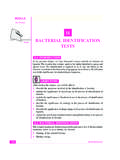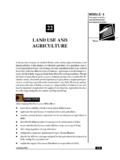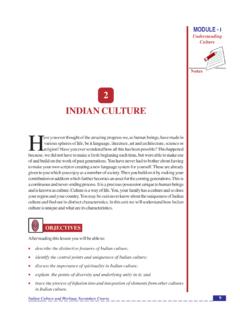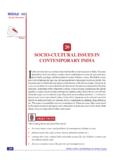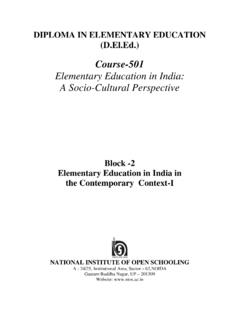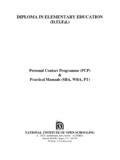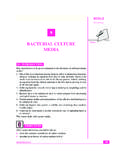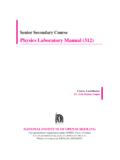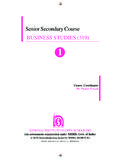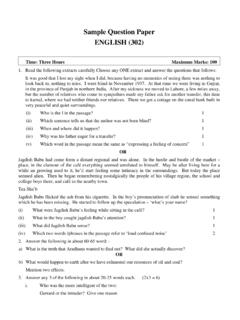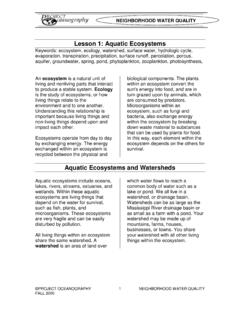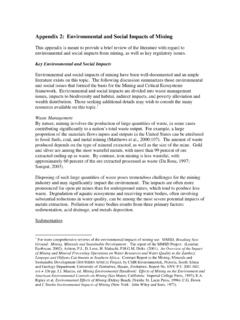Transcription of ECOSYSTEM - National Institute of Open Schooling
1 Environmental Science Senior Secondary CourseNotes76 MODULE - 2 Ecological Conceptsand Issues5 ECOSYSTEMYou know that earth is perhaps the only planet in the solar system that supports life. Theportion of the earth which sustains life is called biosphere. Biosphere is very huge and cannot be studied as a single entity. It is divided into many distinct functional units calledecosystem. In this lesson you will study about the structure and functions of ECOSYSTEM . OBJECTIVESA fter completing this lesson, you will be able to: explain the concept of ECOSYSTEM ; recognize the two major components of ECOSYSTEM ; describe ECOSYSTEM components by giving example of a pond;. list a few natural and human modified ecosystems ; explain energy flow through food chain; differentiate between the various trophic levels- producers, consumers anddecomposers; construct a food chain and represents terrestrial and aquatic ECOSYSTEM ; define food web; define ecological pyramid, pyramid of number, biomass and energy; explain ecological efficiency; explain ECOSYSTEM growth or evolution of ECOSYSTEM ; explain importance of maintaining balanced ECOSYSTEM .
2 ECOSYSTEMIn the previous lesson, you learnt that in nature several communities of organisms livetogether and interact with each other as well as with their physical environment as anecological unit. We call it an ECOSYSTEM . The term ECOSYSTEM was coined by Tansleyin 1935. An ECOSYSTEM is a functional unit of nature encompassing complex interaction77 EcosystemNotesMODULE - 2 Ecological Conceptsand Issuesbetween its biotic (living) and abiotic (non-living) components. For example- a pond is agood example of Components of an ecosystemComponents of ECOSYSTEM : They are broadly grouped into:-(a) Abiotic and (b) Biotic componentsComponents of EcosystemAbiotic components Biotic componentsPhysical factorsInorganic substancesOrganic substances T emperatureWaterProteins HumidityOxygenCarbohydrates LightCarbon dioxideLipids Atmospheric pressureNitrogenProducers ConsumersDecomposers(Green plants)(Animals)(Microorganisms)(a)Abiot ic components (Nonliving): The abiotic component can be grouped intofollowing three categories:-(i)Physical factors: Sun light, temperature, rainfall, humidity and pressure.
3 They sustainand limit the growth of organisms in an ECOSYSTEM .(ii)Inorganic substances: Carbon dioxide, nitrogen, oxygen, phosphorus, sulphur, water,rock, soil and other minerals.(iii)Organic compounds: Carbohydrates, proteins, lipids and humic substances. Theyare the building blocks of living systems and therefore, make a link between the bioticand abiotic components.(b) Biotic components (Living)(i)Producers: The green plants manufacture food for the entire ECOSYSTEM through theprocess of photosynthesis. Green plants are called autotrophs, as they absorb waterand nutrients from the soil, carbon dioxide from the air, and capture solar energy forthis process.(ii)Consumers: They are called heterotrophs and they consume food synthesized by theautotrophs. Based on food preferences they can be grouped into three broadcategories. Herbivores ( cow, deer and rabbit etc.) feed directly on plants,carnivores are animals which eat other animals (eg.)
4 Lion, cat, dog etc.) and omnivoresorganisms feeding upon both plants and animals human, pigs and Science Senior Secondary CourseNotes78 MODULE - 2 Ecological Conceptsand Issues(iii)Decomposers: Also called saprotrophs. These are mostly bacteria and fungi thatfeed on dead decomposed and the dead organic matter of plants and animals bysecreting enzymes outside their body on the decaying matter. They play a very importantrole in recycling of nutrients. They are also called detrivores or detritus Functions of ecosystemEcosystems are complex dynamic system. They perform certain functions. These are:-(i)Energy flow through food chain(ii)Nutrient cycling (biogeochemical cycles)(iii)Ecological succession or ECOSYSTEM development(iv)Homeostasis (or cybernetic) or feedback control mechanismsPonds, lakes, meadows, marshlands, grasslands, deserts and forests are examples ofnatural ECOSYSTEM . Many of you have seen an aquarium; a garden or a lawn etc.
5 In yourneighbourhood. These are man made Types of ecosystemsEcosystems are classified as follows:(i) Natural ecosystems (ii) Man made ecosystems (i) Natural ecosystems (a)Totally dependent on solar radiation forests, grasslands, oceans, lakes, rivers anddeserts. They provide food, fuel, fodder and medicines.(b) ecosystems dependent on solar radiation and energy subsidies (alternative sources)such as wind, rain and tides. tropical rain forests, tidal estuaries and coral reefs.(ii) Man made ecosystems (a) Dependent on solar Agricultural fields and aquaculture ponds.(b) Dependent on fossil fuel urban and industrial will study the details of natural and human made ecosystems in lesson 6 and lesson 7respectively. INTEXT QUESTIONS the abiotic components of - 2 Ecological Conceptsand the biotic components of role do decomposers play in an ECOSYSTEM ? two examples of (i) natural ECOSYSTEM (ii) man made POND AS AN EXAMPLE OF AN ECOSYSTEMA pond is an example of a complete, closed and an independent ECOSYSTEM .
6 It is convenientto study its basic structure and functions. It works on solar energy and maintains its bioticcommunity in equilibrium. If you collect a glass full of pond water or a scoop full of pondbottom mud, it consists of a mixture of plants, animals, inorganic and organic components are found in a pond : Pond ECOSYSTEM (a) Abiotic components(i)Light: Solar radiation provides energy that controls the entire system. Penetration oflight depends on transparency of water, amount of dissolved or suspended particles inwater and the number of plankton. On the basis of extent of penetration of light a pondcan be divided into euphotic (eu=true,photic=light), mesophotic and aphotic of light is available to plants and animals in euphotic zone. No light is availablein the aphotic inorganic andorganic compoundsBacteria and fungi(Reducers)Environmental Science Senior Secondary CourseNotes80 MODULE - 2 Ecological Conceptsand Issues(ii)Inorganic substances: These are water, carbon, nitrogen, phosphorus, calcium anda few other elements like sulphur depending on the location of the pond.
7 The inorganicsubstances like O2 and CO2 are in dissolved state in water. All plants and animalsdepend on water for their food and exchange of gases- nitrogen, phosphorus, sulphurand other inorganic salts are held in reserve in bottom sediment and inside the livingorganisms. A very small fraction may be in the dissolved state.(iii)Organic compounds: The commonly found organic matter in the pond are aminoacids and humic acids and the breakdown products of dead animals and plants. Theyare partly dissolved in water and partly suspended in water.(b) Biotic components(i)Producers or autotrophs: synthesize food for all the heterotrophs of the pond. Theycan be categorized into two groups:-(a) Floating microorganisms and plants(b) Rooted plants(a)Floating microorganisms (green) and plants are called phytoplankton ( phyto - plants, plankton floating). They are microscopic organisms. Sometimes they are so abundantin pond that they make it look green in colour Spirogyra, Ulothrix, Cladophora,Diatoms, Volvox.
8 (b)Rooted plants: These are arranged in concentric zones from periphery to the deeperlayers. Three distinct zones of aquatic plants can be seen with increasing deapth ofwater in the following order:i) Zone of emergent vegetation: . eg. Typha, Bulrushes and Sagittariaii) Zone of rooted vegetation with floating leaves . eg. Nymphaeaiii) Zone of submergent vegetation: eg. All pond weeds like Hydrilla , Rupia,musk grass etc.(ii)Consumers/Heterotrophs are animals which feed directly or indirectly on autotrophseg. Tadpole, snails, sunfish, bass animals can be classified into the following groups(a)Zooplanktons are floating animals. Cyclops, Cypris(b)Nektons are the animals that can swim and navigate at will. Eg. fishes(c)Benthic animals are the bottom dwellers: beetle, mites, mollusks andsome crustaceans.(iii)Decomposers: They are distributed through out the entire in the whole pond but inthe sediment most abundant.
9 There are bacteria and fungi. (Rhizopus, Penicillium,Curvularia ,Cladosporium) found at the bottom of the - 2 Ecological Conceptsand Issues INTEXT QUESTIONS are phytoplanktons? will you search for the decomposers in a pond? do nektons differ from zooplanktons? where do the fishes living at bottom of the pond get their food?_____ FUNCTION ENERGY FLOWTHROUGH ECOSYSTEMFood chains and energy flow are the functional properties of ecosystems which makethem dynamic. The biotic and abiotic components of an ECOSYSTEM are linked Food ChainTransfer of food energy from green plants (producers) through a series of organisms withrepeated eating and being eaten is called a food chain. Grasshopper Frog Snake Hawk/EagleEach step in the food chain is called trophic level. In the above example grasses are 1st,and eagle represents the 5th trophic more example of food chain are given in fig.
10 This process of transfer of energy some energy is lost into the system as heat energyand is not available to the next trophic level. Therefore, the number of steps are limited ina chain to 4 or 5. Following trophic levels can be identified in a food chain.(1)Autotrophs: They are the producers of food for all other organisms of the are largely green plants and convert inorganic material in the presence of solarenergy by the process of photosynthesis into the chemical energy (food). The totalrate at which the radiant energy is stored by the process of photosynthesis in the greenplants is called Gross Primary Production (GPP). This is also known as totalphotosynthesis or total assimilation. From the gross primary productivity a part isutilized by the plants for its own metabolism. The remaining amount is stored by theplant as Net Primary Production (NPP) which is available to Science Senior Secondary CourseNotes82 MODULE - 2 Ecological Conceptsand IssuesP = Producer, H = Herbivore, C = Carnivore, C1 = First level carnivore, C2 = Top CarnivoreFig.
